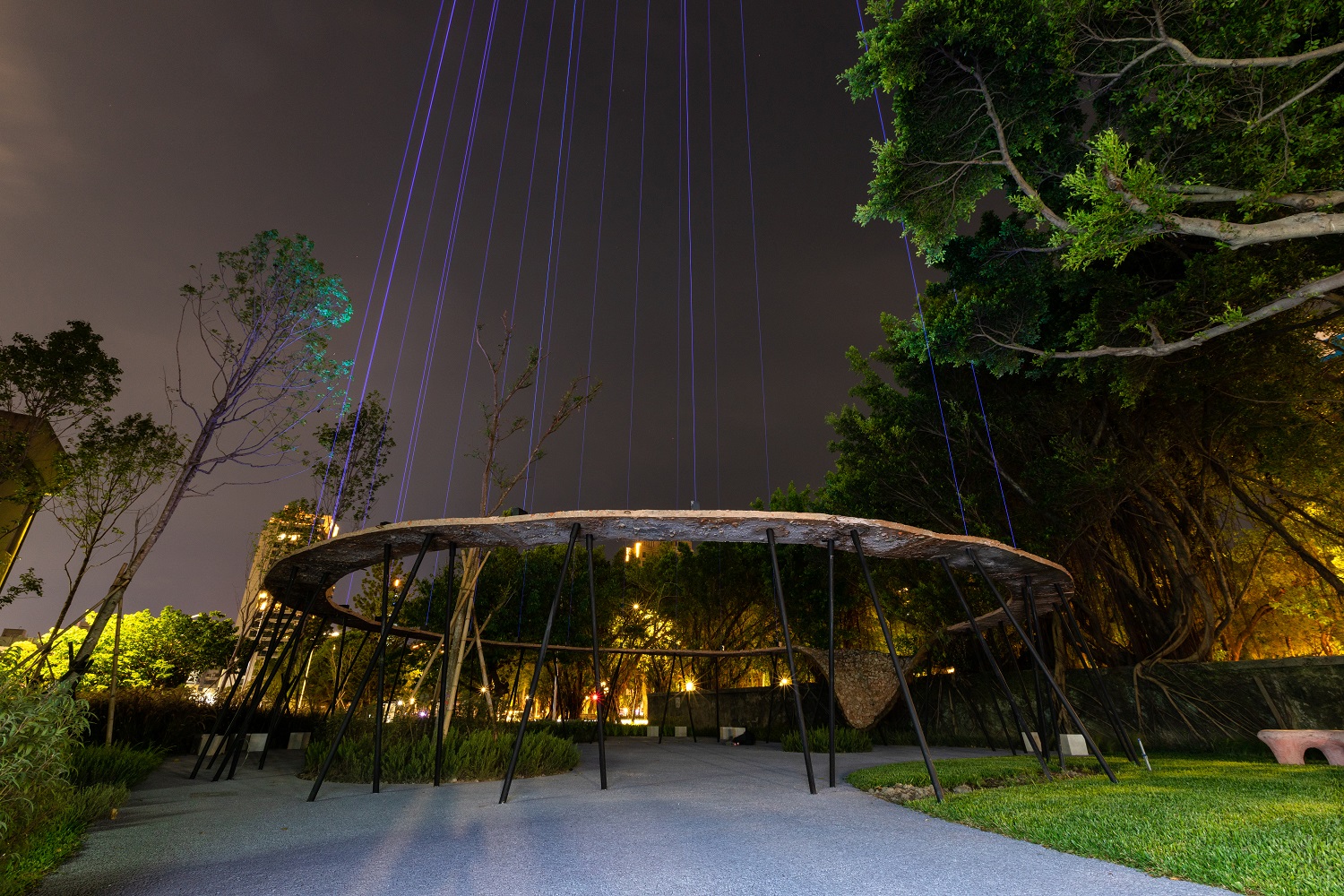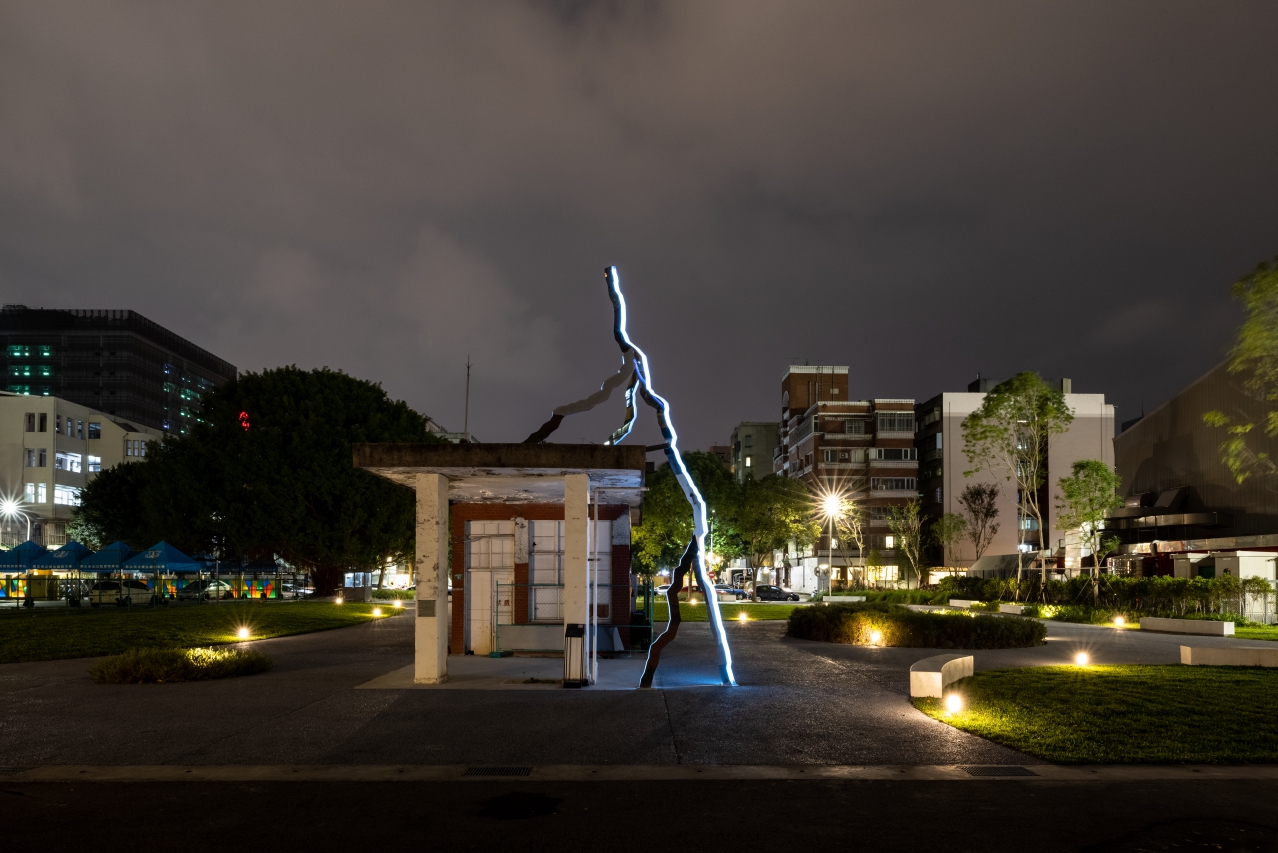在C-LAB園區逐漸打開之際,戶外裝置計畫「交幻場 Wonderland」也以一系列裝置作品迎接走入園區的民眾。計畫內容除了《CLABO+》4/5月號介紹的實驗建築作品《磚循環》之外,還包括「場域色彩」、「工藝地景」、「光環境藝術」等子計畫,以不同面向妝點C-LAB戶外空間。
拆解「交幻場」三字,「交」意味著交流,「幻」則有綺麗幻想的提示,「場」明白點出了落地生根。英文名稱取作「Wonderland」,則蘊含對於整個戶外空間的期許:它首先是一個創作者的遊樂場,而在園區打開後,更是一個屬於市民的遊樂場。但作為一個前軍事基地,有稜有角,未曾以友善使用者的角度設計的這座場域,如何名副其實地成為一座供人們休憩、遊玩的樂園?計畫負責人陳國政談起園區開放前,對於戶外空間的第一印象:「我覺得C-LAB戶外場域沒有表情,非常冰冷,大眾走進來,也只能在幾棟建築物內參與我們展演映的活動,真的很可惜。」於是,他著手推行「交幻場」計畫,從園區的色彩、互動裝置、街道家具等角度切入,為寬廣的戶外場域帶來多變的表情,到了夜晚,還因光環境作品而延伸出不同面貌。這座原先面目嚴肅的園區因而有了更加豐富的姿態與神情,朝著人們擠眉弄眼,彷彿下一刻便會活潑地拉著你我手舞足蹈起來,開心地玩在一塊。
坐落在熙熙攘攘的都會蛋黃區,空間開闊的C-LAB總讓走進的人們不自覺放慢步調,而在園區之中最讓人感到輕鬆寫意的,莫過於錯落在低矮建物之間的草坪了――倘若能躺在都市之中的草原上仰望天空,這座城市,看起來一定與平日所見相當不同。
都市酵母的作品《空總毯》由此出發,設計出這些可坐可臥的街道家具,當C-LAB週末舉辦如「音樂綠洲」活動,人們便可躺臥在《空總毯》上聽音樂,享受自在愜意的下午,或自由探索《空總毯》其他使用的可能性,在鬆開身體的同時鬆開緊繃許久的腦袋,以各種天馬行空的方式與作品互動。在著手製作前,創作團隊亦將園區常見的磚紅、白、灰色等色系納入考量,選用鮮明跳脫的暖黃與天藍兩色,當這些毯子星散在一片青翠的草地上,整體空間似乎都跟著輕盈了起來;而其幾乎貼地、如飛毯般的造形,彷彿一坐上便能乘風遠去,既回應了前述對於仰望天空的渴望,更呼應C-LAB作為舊空軍總基地的歷史背景,保留御風飛行的想像與意象。
 《空總毯》在草坪鋪排,顏色與環境相融。圖/呂國瑋攝影
《空總毯》在草坪鋪排,顏色與環境相融。圖/呂國瑋攝影
如何邀請人們走進一處場所,吸引他們在此駐足呢?或許,「趣味性」是其中的關鍵之一。尤其在C-LAB蛻變為一座開放性的美學公園之後,遊具就更是不可或缺的要件――藝術家范承宗此次為C-LAB所創作的作品,便擔負了這項任務。
 《滾動計畫》和公眾一同創造可移動的大型遊具。圖/呂國瑋攝影
《滾動計畫》和公眾一同創造可移動的大型遊具。圖/呂國瑋攝影
從傳統藤球、手毬的技術出發,范承宗和公眾一同創造可移動的大型遊具,架構好藤球後,呼應手毬以回收的舊和服再造工藝品、舊物再利用的精神,向C-LAB鄰近的居民募集紅、黃、藍、綠、紫等五種色系的舊衣,在工作坊中和成員們一同利用自製的製線機和捲線器,為藤球織上新衣,一顆顆直徑2公尺、色彩鮮豔活潑的大型球體,便成了東草坪上相當引人注目的裝置藝術,更是歡迎大小朋友一起來滾動的遊樂設施。當這些大球滾動的範圍越過了草原,隨著民眾好奇好玩的心一路溜轉,它可能會亮眼地出現在中正堂前,令人困惑地跑到了圖書館外圍,或在仁愛路的大門口向來來往往的人們打招呼。滾動的雖然是球,整個C-LAB卻彷彿也意外地跟著滾動了起來。
當人們在夜間走進C-LAB,不經意繞到近仁愛路一側,便會看見數條從《磚循環》的磚片上直衝天際的藍紫色雷射光,筆直銳利地劃破夜空。藝術家許巽翔的作品《發散度》自《磚循環》延伸,光線的落點避開周遭樹木的位置,在不搶走原作風采的情況下伸展線條,除了讓行經的人們眼睛一亮之外,更挑起他們走進園區一探究竟的好奇心。
這些衝向夜空的光線看似犀利冷絕,猶如場域開放前的圍牆,有著分割與阻絕的意味,卻又是個虛空的、非物質的存在,甚至會受到天候影響,變得更為清晰或者更加模糊。當雲層偏低,光線穿透的介質密度偏高,遠遠看去散成一團光影,《發散度》看起來竟成了一座幽浮;而當空氣相對清澈,在遠處看不清楚的光,在近處卻成了鋒利無比的雷射線,這樣一件許巽翔口中的「靜態光雕塑」,因著人們觀看的角度、距離和當下的天氣而時刻變化,隨時隨地都有驚喜。而這藍紫色的光線,事實上是由紅、藍、綠三個顏色所組成,若時序到了下起綿綿細雨的季候,在光線折射產生的效果之下,人們或許能看見與目前截然不同的色彩。
 光束直射天際,《發散度》在日落後現身。圖/片子國際攝影
光束直射天際,《發散度》在日落後現身。圖/片子國際攝影
相較於《發散度》被動地在原地等待人們發現,座落於仁愛路崗哨旁、散落在植栽之間的《流景》,則以不可預期的光影變化主動爭取觀眾的目光。
 座落於仁愛路崗哨旁、散落在植栽之間的《流景》。圖©臺灣當代文化實驗場
座落於仁愛路崗哨旁、散落在植栽之間的《流景》。圖©臺灣當代文化實驗場
配合景觀工程在現場培育的多種植栽,《流景》以內凹的曲線,等高線般一圈一圈在植被之間發散光亮,發光的速度和方向則取決於現場即時採集到的風速和風向。光線隨著風的吹拂強度而忽明忽暗,原先僅能以身體感受到的風,透過《流景》光的流動,讓風變得可見。不可見的事物經由技術與數據轉化為可見的光,呼應觀者在當下環境的身體感知,有時輕快流轉,有時則慢速停滯,作品與觀眾感官之間變得更為密切。除了以媒材輕巧為主要考量,作品整體的高度設計低於附近的植栽,襯托植物的同時也與植物共生共榮。許巽翔更期待附近的植物在日後逐漸蔓長開來,終會有一日會淹過這件作品,甚至在《流景》一圈一圈的孔隙之中生長,讓人們在白天經過時難以注意到這個作品,直到光影在夜間流轉,才又驚又喜地發現它低調卻活潑的存在。
日治時期曾為工業研究所,戰後又作為空軍總司令部,C-LAB如今仍保有歷史歲月的斑斑痕跡,過往時間彷彿在此被保留下來;而從臺北市中心的空照圖來看,也能見到在都市化進程之下,城市建物密度極高,然而這樣的高密度綿延到了空總卻突然被打斷,留下一處面積不小的空白。無論在時間或空間上,C-LAB的存在都像是一種錯置,與當下的時空共存,卻又好似不屬於現下的時空。
作品《高壓電》即試圖呼應園區時空上的錯置感,當一道閃電忽然從天而降,喚起人們對於光最為古老、原始的視覺經驗,卻又發生在對於電和光早已習以為常、高度發展的現代都會區時,瞬間乍現的光芒彷彿將人們拉回科技尚未發達、電與光源都不易取得的時代,在閃電消失時,一切則又恢復如常。這件預計高7至8公尺的作品採用鏡面鋼板與LED燈為媒材,由於鏡面鋼板會反映周遭環境,在LED燈未亮起時易與周遭空間融為一體,不易察覺,在LED燈閃爍時,裝置才如閃電般閃現在觀者眼前,劈下的瞬間異化原本熟悉的景物,同時也打開一道裂縫,讓嶄新的想像在此發生。
 《高壓電》試圖呼應園區時空上的錯置感,當一道閃電忽然從天而降,喚起人們對於光最為古老、原始的視覺經驗。圖©臺灣當代文化實驗場
《高壓電》試圖呼應園區時空上的錯置感,當一道閃電忽然從天而降,喚起人們對於光最為古老、原始的視覺經驗。圖©臺灣當代文化實驗場